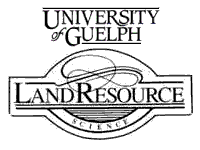
 |
Dr. Susan Glasauer Assistant Professor Department of Land Resource Science University of Guelph Guelph, Ontario, Canada Telephone: (519) 824-4120 x52453 Fax: (519) 824-5730 E-mail: glasauer (at) uoguelph (dot) ca Website: http://www.uoguelph.ca/~glasauer/ |
 |

Research
Overview .
Introduction .
Members .
Facilities .
Current Projects .
Collaborations .
Grad Student Opportunities
OverviewMy research is concentrated in the following areas:
Introduction
From our perspective at the top of the food chain and at the far edge of evolutionary time, bacteria are generally below our line of sight. We can spend a lifetime without ever considering the mountains of bacteria that are under our feet, buried in soils and sediments. These simple organisms defy evolution by maintaining the ancestral forms and functions developed by their ancestors billions of years ago. What is their role? Current research is unearthing new evidence that subsurface bacteria have had a profound impact on shaping our planet, as well as much more controversial evidence that bacteria have existed on other planets. Bacteria from all major taxonomic groups have been found in metal-rich habitats such as mineral ores, acidic soils and polluted environments. All microorganisms have essential metabolic and structural requirements for specific metals. Intense competition for some metals, coupled with low bioavailability, has driven the evolution of tightly regulated mechanisms for metal acquisition. On the other hand, all metals are toxic in excess; this toxicity has led cells to develop diverse mechanisms of defense. A third general process by which bacteria interact with metals is metal respiration. Higher organisms can only breathe O2, yet there is strong evidence that dissimilatory metal reduction, a process whereby metals serve as terminal electron acceptors during respiration, predates O2 respiration. Dissimilatory metal reduction may well be the most ancient respiratory process. The chemical transformation of metals during respiration can lead to the crystallization of minerals; mineral oxides and sulfides are a form of solid metal. The ability to understand and harness such a process has enormous implications. For example, bacteria can be used to immobilize toxic, soluble metals in mine wastes. Signatures of ancient bacterial respiration may be preserved in some ancient rock structures – in particular the Banded Iron Formations. In spite of their utility and enormous global impact, the origin of these vast layered deposits remains enigmatic. In our group, articulating bacterial metal interactions has two thrusts: 1) the development of practical applications for bioremediation, and 2) contributing to basic research aimed at understanding the role of microorganisms in shaping Earth to its present form. This includes investigating the links between metal respiration and the degradation of organic contaminants. Bacteria spend their brief lives in semi-permeable, rubbery wetsuits that define their zone of contact with the extracellular environment. This interfacial zone is a natural area of focus for us. Adhesion mechanisms are, therefore, of strong interest, because of their key roles in mineral dissolution as well as in bacterial mobility. Understanding the interface between minerals and bacterial membranes requires perspectives from geochemistry, biochemistry and microbiology; we are also interested in molecular biology techniques to articulate the composition and function of microbial communities. Our research approaches are necessarily interdisciplinary. We apply a suite of methods to address questions on microbe-mineral interactions. Electron microscopy is an especially powerful one that permits us to directly observe bacteria-metal interactions. The electron microscopes available at the NSERC-CFI Guelph Regional Integrated Imaging Facility (GRIFF) allow us to perform element mapping, electron diffraction and high resolution imaging at nanometer scales. The pages on this website show some results from our studies of metal-reducing microorganisms using the GRIFF microscopes. Other indispensable methods include synchrotron-based microscopy tools for tracking metal chemistry and mineral composition, X-ray diffraction, fluorescence microscopy, and atomic force microscopy. Research Group MembersMy research group consists of the following individuals: 
Left to Right: Dr. Kari Dunfield, Al Mattes, Dr. Susan Glasauer, Dr. Pedro Antunes
Deborah Rheinstein, Christine Cousins More detailed information about these individuals can be found on their personal websites:
FacilitiesComing soon. Current ProjectsComing soon. CollaborationsComing soon. Grad Student OpportunitiesComing soon. |